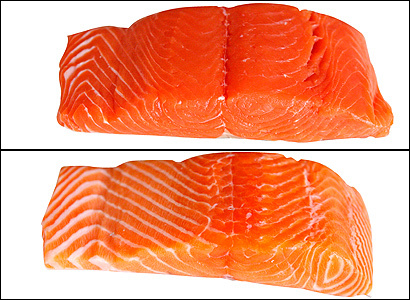 Wild salmon (top) and farmed salmon (bottom). (Wendy Maeda/Globe Staff) |
Farmed salmon has raised concern among consumers
By Jonathan Levitt, Globe Correspondent | July 4, 2007
Fresh wild salmon is a beautiful seasonal delicacy, but these days more than half of the salmon eaten in the United States is farmed. Even within the farmed varieties, there are many different tastes, and all kinds of aquaculture systems in place.
What has worried consumers in recent years are reports that farmed salmon are being given antibiotics, that the fish are eating other fish with contaminants, and that salmon are being fed color-enhancing pigments to turn the flesh its characteristic pink. Becky Goldburg, senior scientist at Environmental Defense in New York, says that there have been a lot of improvements in salmon aquaculture, but many still need to be made. "There is no easy answer on farmed salmon," she says. "Some fish are better than others but there is still no single source that's low in contaminants and ecologically benign."
Sebastian Belle, executive director of the Maine Aquaculture Association, whose group represents Atlantic farms, thinks that raised salmon in Maine and Eastern Canada may come pretty close. "We have some of the cleanest fish and strictest regulations in the world," he says. "Everything is available for public scrutiny. In places like Chile you would never be able to find out what's really going on."
Belle says that the old way of salmon farming was to crowd the fish in a small space. "We were pushing too hard," he says. "There was no synergy. We had disease, escapes, sea lice." Now salmon farmers leave the pens fallow for a year and have fewer disease problems.
Maine salmon are almost antibiotic-free, says Belle. Before the salmon go to market, any antibiotics are stopped and the fish are monitored and fed normal feed for 45 to 60 days; regulations require this.
Other sticking points for consumers are high levels of cancer-causing pollutants like polychlorinated biphenyls (PCBs) and dichloro - diphenyl - trichloroethane (DDT) concentrated in the fat of farmed fish. PCBs and DDT have been banned in the United States for 30 years but linger in water and soil because they biodegrade slowly. The farmed salmon accumulate the contaminants from their diet of ground fish and fish oil.
Belle maintains that the contaminants have never been a big issue in the United States. "It was a problem in Europe two years ago," he says. "Now they test the feed for PCBs and DDT and make sure they are not there."
Goldburg of Environmental Defense says that ideally -- with some sort of labeling system in place -- consumers would be able to distinguish between fish with high levels of contaminants and fish with lower levels. "Contaminants vary widely from site to site and fish to fish," she says. "More terrestrial based food would lower contaminants. Farms could also source cleaner fish meal and oil."
There has also been concern among consumers that farmed salmon are too high in saturated fats. Belle says that it depends on where the fish is raised. If they're swimming in Chile, for instance, where there isn't much tide or current, the fish will deposit food energy as fat. In Maine, salmon swim against strong currents, so the energy turns to muscle. "Maine farm raised fish has a similar fat-to-muscle ratio to wild fish," Belle says.
Farmed salmon, says Tim Fitzgerald, a scientist in the oceans program, who works with Goldburg at Environmental Defense, "are high in Omega-3's, but [in] other fats as well."
Farming salmon on coastlines where the wild species are also swimming can cause complicated ecological problems. Containment nets for the farmed fish can tear, so the farmed may interbreed with or crowd out wild species. Belle acknowledges that escapes have happened, but says that their containment management system is audited by a third party and is carefully checked.
Tagging fish is designed to help the problem. In Maine a new program tags all farmed fish so that if they escape they can be traced. "Finally there will be some accountability," says Goldburg.
As to the feed and coloring, other points of contention, Atlantic farms used to give salmon mostly fish meal and fish oil, but have switched to a pelleted dry food made up of soybeans, wheat, and corn, along with fish oil. Feeding has become more efficient and now, according to Belle, the fish products make up only about one-third of the diet.
To mimic the reddish color of the wild fish, which comes from a steady diet of fish and crustaceans, farmed fish are fed carotenoid pigments from krill and other sea creatures or pellets with red dyes -- either canthaxanthin or astaxanthin . This turns flesh that would naturally be brownish-pink into bright coral. Fitzgerald of Environmental Defense says, "It usually surprises consumers that the farmed fish have to be colored. But it's not an environmental issue or to my knowledge, a health issue either."
The aquaculture industry may change many practices, but it probably won't budge on the color.
 选择“Disable on www.wenxuecity.com”
选择“Disable on www.wenxuecity.com”
 选择“don't run on pages on this domain”
选择“don't run on pages on this domain”

